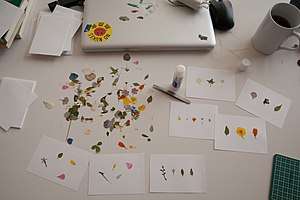Oshibana
Oshibana is the art of using pressed flowers and other botanical materials to create an entire picture from these natural elements. This foliage, including whole flowers, petals, leaves and varied organic pieces, are pressed until dry and flat, using a variety of pressing methods. These elements are then used to "paint" an artistic composition. The origin of this art form has been traced to 16th century Japan, but it is now practiced worldwide. The resulting artwork is referred to as an Oshibana.[1]

Historical Background
As early as the 16th century, Samurai warriors in Japan were said to have created Oshibana as one of their disciplines to promote patience, harmony with nature and powers of concentration. This art of drawing with petals has been said to have gradually spread with the advent of trade with the West. This art form became popular in the Holy Land in the late 1890s and into the 20th century when elaborate souvenir books combining photographs of the holy sites and the pressed flowers gathered at these sites. These photographs and pressed, dried flowers were artistically formatted and bound between olive wood covers to be sold to visitors.[2] Similarly, as botanists in Europe began systematic collection and preservation of specimens, art forms with the pressed plant materials developed, particularly during Victorian times. American actress Grace Kelly, during her years as Princess Grace of Monaco, practiced Oshibana and helped promote the art of pressed flowers worldwide, employing pressed botanical materials sent to her from abroad. "My Book of Flowers",[3] by Princess Grace of Monaco with Gwen Robyns, published in 1980, includes chapters on her art form.[4]
Emerging Methods
Oshibana artists are employing various new technologies in pressing methods, framing techniques and color enhancing to help the pressed materials keep their beauty through the years. Nobuo Sugino, pioneering figure in contemporary Oshibana, and his father developed a groundbreaking method of using dessicant papers to press flowers, helping hold color.[5] A method of vacuum-sealing frames to lock in color, texture and clarity of the petals and leaves and help prevent moisture and fungi intrusion was also developed in Japan and is now practiced by many Oshibana artists worldwide.[6]
Contemporary Societies
In recent decades, the emergence of several international art associations and schools have helped popularize and increase the recognition of Oshibana as a unique art form through classes, conferences, international exhibitions and competitions. Among them:
- International Pressed Flower Art Society, founded by Nobuo Sugino, in Yokohama, Japan in 1999.
- World Wide Pressed Flower Guild, founded in North Carolina, USA.
- Pressed Flower Guild, established in 1983 in the UK by Joyce Fenton.
- Philadelphia Flower Show, organized by the Pennsylvania Horticultural Society, host of the annual Oshibana/pressed flower art competition.
- Oshibana Art, a Japanese Pressed Flower organization and school founded by Mirian Tatsumi in 1996 in São Paulo, Brazil
References
- "Art Floreo". Retrieved September 26, 2015.
- "Flowers and Pictures of the Holy Land". The Getty Research Institute. Retrieved September 26, 2015.
- Kelly, Grace; Robyns, Gwen (1980). My Book of Flowers. Doubleday. p. 224. ISBN 0385140762.
- "A Celebration of Grace". Retrieved November 17, 2015.
- Maruko, Mami. "World of freeze-framed flowers at Mitsukoshi". Culture. The Japan Times. Retrieved October 3, 2015.
- "Oshibana Art: Japanese Pressed Flowers". Oshibana Art. Retrieved November 17, 2015.